Photo #: NH 65735
USS Niagara (1857-1885)
Line engraving published in the "Illustrated Times of London",
15 August 1857, depicting activity on board during the first
attempt to lay a trans-Atlantic telegraph cable.
U.S. Naval Historical Center Photograph.
Online Image: 174KB; 740 x 530 pixels |
 |
Photo #: NH 1589
"Atlantic Telegraph Polka"
Lithographic cover for a musical composition by A. Talexy, commemorating
the successful laying of the first trans-Atlantic telegraph cable.
Published in Boston, Massachusetts, 1858
Its illustrations include a view of USS Niagara (left)
and HMS Agamemnon beginning to lay the cable, a chart
of the cable route, a depiction of the cable, and scenes of the
U.S. Capitol Building and Windsor Castle. The cable's first message,
from Queen Victoria to President James Buchanan, was sent in
August 1858, but it failed after a few weeks of operation.
Courtesy of President Franklin D. Roosevelt, 1936.
U.S. Naval Historical Center Photograph.
Online Image: 104KB; 510 x 765 pixels |
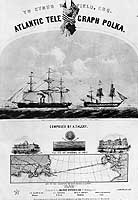 |
Photo #: NH 65487
"Atlantic Cable Half a Century Old"
Pen & ink drawing by Samuel Wart Stanton, circa 1908, prepared
in honor of the 50th anniversary of the 1858 laying of the first
successful trans-Atlantic telegraph cable.
The artwork features a depiction of USS Niagara (right)
and HMS Agamemnon beginning to lay the cable in late July
1858. Its first message, from Queen Victoria to President James
Buchanan, was sent on 16 August, but the cable operated for only
three weeks before it failed.
U.S. Naval Historical Center Photograph.
Online Image: 90KB; 740 x 310 pixels |
 |
Photo #: NH 59571
USS Niagara (1857-1885)
Arriving at Yeddo, Japan, with the Japanese Ambassador to the
United States on board, 10 November 1860.
Line engraving published in "Harper's Weekly", 1861.
U.S. Naval Historical Center Photograph.
Online Image: 150KB; 740 x 615 pixels |
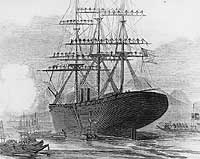 |
Photo #: NH 59145
"Cutting Out of the Southern Schooner 'Aid,' off Mobile,
by the Boats of the U.S. Steam Frigate Niagara, assisted by the
U.S. Steamer Mount Vernon, June 5, 1861."
Line engraving published in "Frank Leslie's Illustrated
Newspaper", 1861. USS Mount Vernon is shown at right.
U.S. Naval Historical Center Photograph.
Online Image: 129KB; 740 x 600 pixels |
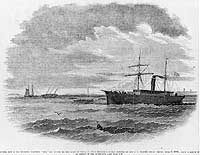 |
Photo #: NH 58783
Cutter of USS Niagara
Is hit by a shell from CSS Ivy, near the mouth of the
Mississippi River on 3 November 1861.
Line engraving published in "The Soldier in our Civil War",
Volume I, page 126.
U.S. Naval Historical Center Photograph.
Online Image: 165KB; 740 x 610 pixels |
 |
Photo #: NH 59009
"View of Ship Island, Louisiana. -- By our Special Artist
on Board the 'Sagamore'"
Line engraving, published in "Harper's Weekly", 1862,
depicting several U.S. Navy ships anchored off the Federal base
at Ship Island in early 1862. Ships are (from left to right)
Winona, New London, Niagara, Sagamore,
Wissahickon, and Massachusetts. Other features
identified, in the center and right background, are Fort Massachusetts
on Ship Island, the 9th Connecticut and 22nd Massachusetts Regiments
and a military camp.
U.S. Naval Historical Center Photograph.
Online Image: 128KB; 740 x 520 pixels |
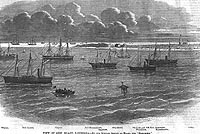 |
Photo #: NH 59345
The Tower of Belem, Lisbon Harbor, Portugal
Firing on USS Niagara and USS Sacramento, 28 March
1865.
Line engraving published in "Harper's Weekly", 13 May
1865, page 301.
This incident resulted when Niagara was shifting her berth
in the harbor and was briefly fired upon by the harbor fortification,
on the presumption that she was trying to follow CSS Stonewall
to sea before expiration of the 24-hour waiting period mandated
by international law. Portugal later apologized for the incident.
U.S. Naval Historical Center Photograph.
Online Image: 134KB; 740 x 460 pixels |
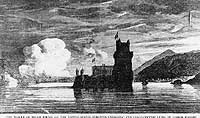 |
